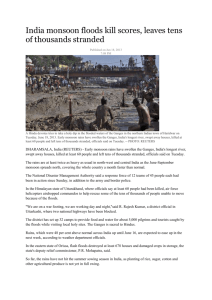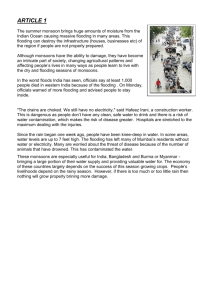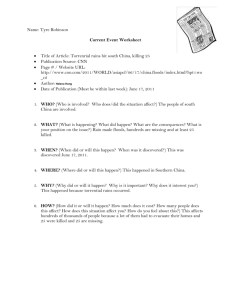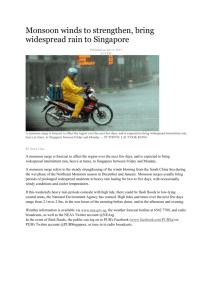Flooding in India & China
advertisement
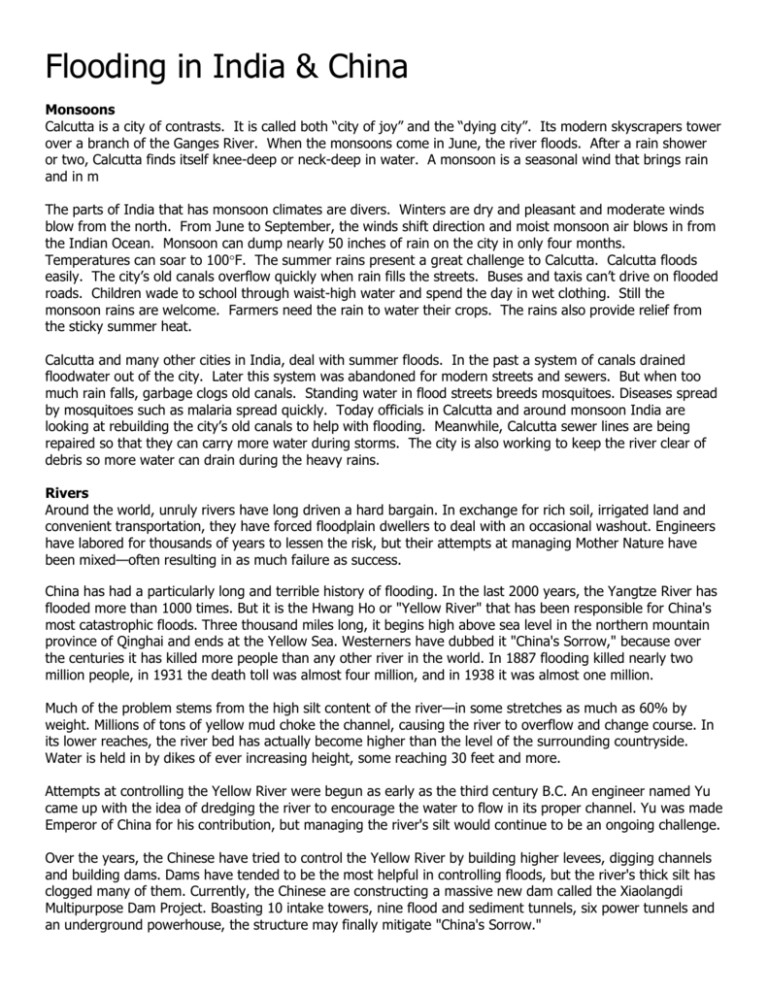
Flooding in India & China Monsoons Calcutta is a city of contrasts. It is called both “city of joy” and the “dying city”. Its modern skyscrapers tower over a branch of the Ganges River. When the monsoons come in June, the river floods. After a rain shower or two, Calcutta finds itself knee-deep or neck-deep in water. A monsoon is a seasonal wind that brings rain and in m The parts of India that has monsoon climates are divers. Winters are dry and pleasant and moderate winds blow from the north. From June to September, the winds shift direction and moist monsoon air blows in from the Indian Ocean. Monsoon can dump nearly 50 inches of rain on the city in only four months. Temperatures can soar to 100F. The summer rains present a great challenge to Calcutta. Calcutta floods easily. The city’s old canals overflow quickly when rain fills the streets. Buses and taxis can’t drive on flooded roads. Children wade to school through waist-high water and spend the day in wet clothing. Still the monsoon rains are welcome. Farmers need the rain to water their crops. The rains also provide relief from the sticky summer heat. Calcutta and many other cities in India, deal with summer floods. In the past a system of canals drained floodwater out of the city. Later this system was abandoned for modern streets and sewers. But when too much rain falls, garbage clogs old canals. Standing water in flood streets breeds mosquitoes. Diseases spread by mosquitoes such as malaria spread quickly. Today officials in Calcutta and around monsoon India are looking at rebuilding the city’s old canals to help with flooding. Meanwhile, Calcutta sewer lines are being repaired so that they can carry more water during storms. The city is also working to keep the river clear of debris so more water can drain during the heavy rains. Rivers Around the world, unruly rivers have long driven a hard bargain. In exchange for rich soil, irrigated land and convenient transportation, they have forced floodplain dwellers to deal with an occasional washout. Engineers have labored for thousands of years to lessen the risk, but their attempts at managing Mother Nature have been mixed—often resulting in as much failure as success. China has had a particularly long and terrible history of flooding. In the last 2000 years, the Yangtze River has flooded more than 1000 times. But it is the Hwang Ho or "Yellow River" that has been responsible for China's most catastrophic floods. Three thousand miles long, it begins high above sea level in the northern mountain province of Qinghai and ends at the Yellow Sea. Westerners have dubbed it "China's Sorrow," because over the centuries it has killed more people than any other river in the world. In 1887 flooding killed nearly two million people, in 1931 the death toll was almost four million, and in 1938 it was almost one million. Much of the problem stems from the high silt content of the river—in some stretches as much as 60% by weight. Millions of tons of yellow mud choke the channel, causing the river to overflow and change course. In its lower reaches, the river bed has actually become higher than the level of the surrounding countryside. Water is held in by dikes of ever increasing height, some reaching 30 feet and more. Attempts at controlling the Yellow River were begun as early as the third century B.C. An engineer named Yu came up with the idea of dredging the river to encourage the water to flow in its proper channel. Yu was made Emperor of China for his contribution, but managing the river's silt would continue to be an ongoing challenge. Over the years, the Chinese have tried to control the Yellow River by building higher levees, digging channels and building dams. Dams have tended to be the most helpful in controlling floods, but the river's thick silt has clogged many of them. Currently, the Chinese are constructing a massive new dam called the Xiaolangdi Multipurpose Dam Project. Boasting 10 intake towers, nine flood and sediment tunnels, six power tunnels and an underground powerhouse, the structure may finally mitigate "China's Sorrow."

